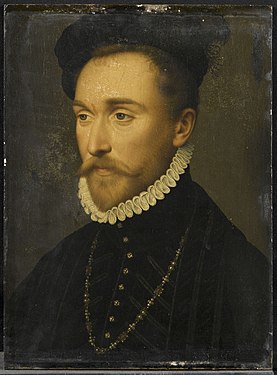Albert de Gondi
Albert de Gondi (4 November 1522 in Florence – 1602) seigneur du Perron, comte, then marquis de Belle-Isle (1573), duc de Retz (from 1581), was a marshal of France and a member of the Gondi family. His father was Guidobaldo, seigneur de Perron, who became a banker at Lyon, and his mother was Marie-Catherine de Pierrevive - his siblings included cardinal Pierre de Gondi. His motto was Non sine labore.

Life
Albert de Gondi was the son of Marie Catherine Gondi. He joined the court of Henry II of France on his accession in 1547 and around 1550 joined a company of chevau-légers. On 13 August 1554 he served at the battle of Renty and soon afterward Henry II soon made him a gentleman of the chamber and master of the wardrobe to Charles of France. He continued to occupy these posts under Charles X and Henry III.
In 1555, he won a great reputation in Italy, at the sieges of Ulpiau and Coni and the taking of Verceil. He also served with great distinction in the expeditions into Piedmont and Corsica. On 10 August 1557 he participated in the Battle of Saint-Quentin and on 13 July 1558 at the battle of Gravelines. He was in 1559 made captain of a company of gendarmes and fought at their head at the battle of Saint-Denis on 10 November 1567, at Jarnac on 13 March 1569 and at Moncontour on the following 3 October.
He was chosen to carry news of victory at Moncontour to the king and was the same month made captain of 50 men at arms. Knighted on the king's orders, he won a place as conseiller d’État. He was then employed as French ambassador to the Imperial court at Vienna and on 22 October 1570 was the French king's proxy at his marriage to Elizabeth of Austria. On the death of marshal Vieilleville, the comte de Retz was made governor and lieutenant-general in the pays messin, and governor of the town of Metz, by provisions granted at Duretal on 30 November 1571. He was then made captain of the first company of gentlemen of the king's household after the death of the duc de Roannois in December the same year.
In 1572 he was one of the advisors in council with Catherine de' Medici at the Tuileries on the evening of August 22, the night before the ordering of the St. Bartholomew's Day massacre; he and other Italian advisors were afterwards given much of the blame for the massacres by the Huguenots: "All the contemporary chronicles (save one which he is suspected of authoring) incriminate him in the St Bartholomew's massacres".[1] At the end of 1572 he was charged with a mission to Elizabeth I of England, successfully persuading her not to give aid to French Protestants. At the beginning of 1573, coming back from London, the comte de Retz commanded a squadron and forced count Montgomery to abandon Belle-Isle. The French king raised this town to a marquisate and granted it to the count of Retz, who then set out for the 1573 Siege of La Rochelle, where he was wounded.
A vacancy for a marshal of France came about due to the death of the maréchal de Tavanes, and this was granted to the comte de Retz by provisions given at the château de Boulogne on 6 July 1573[2] and registered by the constable on 2 August the following year. He then became governor of Provence, by provisions given in the same place and on the same day, 6 July 1573 : these were registered at the parliament of Provence, 22 August 1574.
Maréchal de Retz then left his governorship at Metz. He accompanied Henri III, duc d’Anjou to Poland, returned to France with him and represented the constable at this prince's consecration, on which occasion he was also admitted to this prince's privy council. He dismissed his company of 100 gentlemen in the month of January 1575 and was made commander in chief of the army in Provence, forcing the towns and castles rebelling against Henry to submit to him and placing the town of Menerbes back under obedience to the pope.
Marriage and issue
On 4 September 1565, he became the second husband of Claude Catherine de Clermont-Tonnerre, baroness of Retz and of Dampierre, daughter of Claude de Clermont-Tonnerre, baron de Dampierre, with whom he had 10 children:
- Charles (1569-1596), marquis de Belle-Isle, général des Galères de France, whose descendants end with the women of the 18th century ;
- Claude-Marguerite (1570-1650), who married Florimond, marquis de Piennes (+1592) ;
- Françoise (+1627), who married Lancelot Grognet de Vassé ;
- Gabrielle who married Claude de Bossut, seigneur d'Escry ;
- Hyppolite (+1646) who married Léonor de Magdelaine marquis de Ragny ;
- Henri de Gondi, cardinal de Retz (1572-1622), bishop of Paris.
- Louise (1572-1661), nun ;
- Madelaine (+1662), nun ;
- Philippe-Emmanuel (1581-1626), comte de Joigny, marquis de Belle-Isle, baron de Montmirel, général des Galères de France, who married Françoise de Silly (+1625), dame de Commercy, daughter of Antoine, comte de La Rochepot, whose descendants end with the 18th century women.
- Jean-François de Gondi, cardinal de Retz (1584-1654), first archbishop of Paris.
.svg.png)
References
- pp 26-7 The Duke of Anjou and the Politique Struggle During the Wars of Religion, Mack P. Holt, Cambridge University Press, 2002, ISBN 0-521-89278-3, ISBN 978-0-521-89278-0
- Histoire généalogique de la maison de Gondi, tom. II, pag. 360 ; les comptes de l’ordinaire des guerres et dans les registres de la connétablie. Moréri et l’historien des Grands Officiers de la Couronne se trompent donc, lorsqu’ils datent cette nomination, le premier de 1567, le second de 1574.
- Chronologie militaire, tom. II, pag. 322 ; Histoire généalogique de la maison de Gondi, Histoire des Grands Officiers de la Couronne, de Thou, et Moréri.